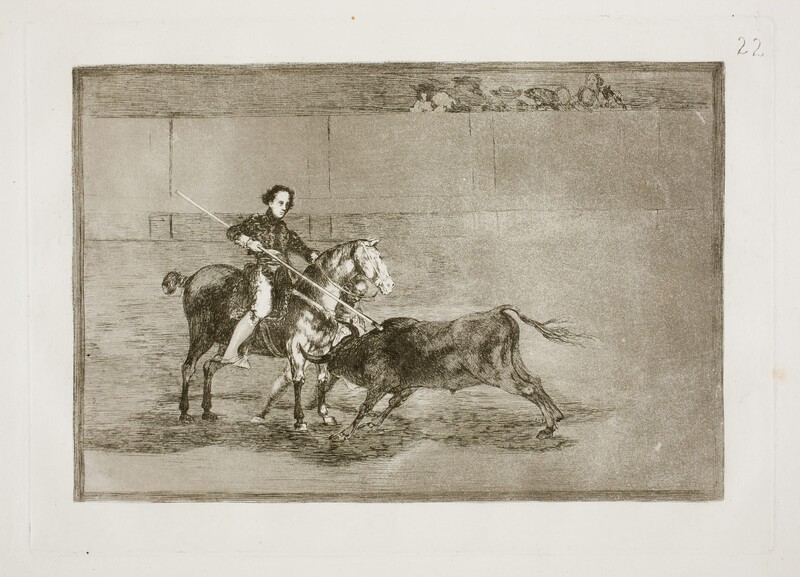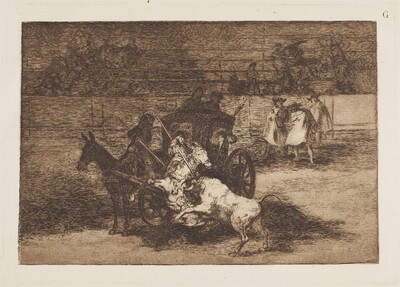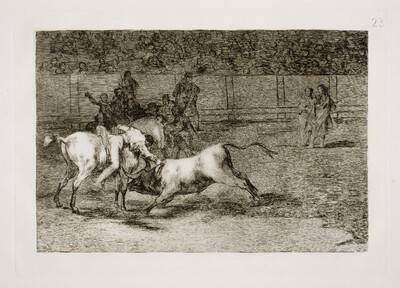- Cronología
- 1814 - 1816
- Dimensiones
- 250 x 351 mm
- Técnica y soporte
- Aguafuerte, aguatinta, punta seca, buril y bruñidor
- Reconocimiento de la autoría de Goya
- Documented work
- Ficha: realización/revisión
- 02 Oct 2021 / 22 Jun 2023
- Inventario
- -
22 (print, upper right-hand corner)
Goya (inverted, printed, down left-hand corner)
See How the ancient Spaniards hunted bulls on horseback in the countryside
A state proof is preserved before aquatint and burin.
The plate is preserved in the National Chalcography (no. 355) and has the work Combat of a harnessed carriage with two mules ( Bullfighting G).
See How the ancient Spaniards hunted bulls on horseback in the countryside
In the scene we see a woman, dressed as a man, on horseback, stinging the bull in front of her in the middle of a bullring, while a farmhand, almost hidden behind the equine, seems to be leading him towards the luck of the sticks, preventing him from escaping.In the background on the right, behind the barrier, a small group of spectators can be glimpsed, which is somewhat blurred by the aquatint. Apart from this small group of spectators, the rest of the barrier and the stands are empty. As in the other prints in the series, the bull stands out, charging at the horse, which he almost stabs with his horns.
Gassier believes that Goya may have witnessd the scene in the Saragossa bullring, as the protagonist, the famous Pajuelera, was well known in the third quarter of the 18th century for her fearlessness in the luck of the bulls and for being a pioneer of women's bullfighting. Teh bullfighter´s name was actually Nocolasa Escamilla and when she was young she sold straws or sulphur wicks, the first version of today marches, hence her stage name.
Both Beruete and Bagüés comment on the difference between the engraving and the preparatory drawing of the same, also entitled The manly courage of the famous Pajuelera in Zaragoza, in the expression on the protagonist's face. Sánchez Cantón and Glendinning, for their part, stress the same aspect, the latter emphasising that the bullfighter's face in the drawing is less expressive and more friendly. Between drawing and print there are also variations in aspects such as the Pajuelera's hairstyle and the audience, which are much more abundant in the preparatory study.
Matilla explains the print as a representation of the transition from bullfighting on horseback, which had been predominant in the past, to bullfighting on foot. In fact, according to Matilla, it shows an unregulated cast, like those performed in his prints of the series by bullfighters still in transition, such as Martincho, Apiñani, the student from Falces and Mariano Ceballos.
Due to its composition and subject matter, the work is related to the following engraving of Bullfighting, entitled Mariano Ceballos, aka "the Indian", kills the bull from his horse.
-
Grabados y dibujos de Goya en la Biblioteca NacionalBiblioteca NacionalMadrid1946catalogue Elena Páez Ríos
-
Goya en la Biblioteca Nacional. Exposición de grabados y dibujos en el sesquicentenario de su muerteBiblioteca NacionalMadrid1978May - June 1978
-
Grabados de Goya: colección propiedad de la Biblioteca Nacional, que se conserva en su Gabinete deCasa de la Amistad de MoscúMoscow1979exhibition displayed from January 18th to 31st 1979
-
1984
-
Madrid1987
-
Madrid1990
-
Goya grabadorFundación Juan MarchMadrid1994consultant editors Alfonso E. Pérez Sánchez and Julián Gállego, from January 14th to March 20th 1994
-
Goya grabadorMuseo del Grabado Español ContemporáneoMarbella1996from March 8th to May 5th 1996
-
Zaragoza1996
-
Ydioma universal: Goya en la Biblioteca NacionalBiblioteca NacionalMadrid1996from September 19th to December 15th 1996cat. 281
-
Schlaf der Vernunft. Original radierungen von Francisco de GoyaMunich2000
-
Madrid2002
-
Madrid2002
-
Bilbao2012
-
Goya et la modernitéPinacothèque de ParisParís2013from October 11st 2013 to March 16th 2014cat. 34
-
Zaragoza2017
-
2022
-
MadridBlass S.A.1918p. 134
-
ZaragozaTip. del Hospicio1926pp. 32-33
-
1946pp. 177-216, espec. pp. 200-201
-
BarcelonaTartessos-F. Oliver Branchfelt1946 (reed. 1951)
-
MadridMuseo del Prado1954cat. 175
-
1961pp. 120-127
-
OxfordBruno Cassirer1964vol. II, 1964, pp. 337-338, cat. 225
-
Vie et ouvre de Francisco de GoyaParísOffice du livre1970p. 278, cat. 1194
-
MilwakeeMilwaukee Art Museum1986p. 24
-
Goya, toros y torerosMadridMinisterio de Cultura, Comunidad de Madrid1990p. 105, cat. 39
-
MadridCaser-Turner1992pp. 26 y 34-35
-
Goya y Aragón. Familia, amistades y encargos artísticoscol. Col. Mariano de Pano y RuataZaragozaCaja de Ahorros de la Inmaculada de Aragón1995pp. 227-229
-
Catálogo de las estampas de Goya en la Biblioteca NacionalMadridMinisterio de Educación y Cultura, Biblioteca Nacional1996cat. 344
-
Ydioma universal: Goya en la Biblioteca NacionalMadridBiblioteca Nacional, Sociedad Estatal Goya 96 y Lunwerg1996p. 251
-
SevillaSociedad Estatal Nuevo Milenio2001pp. 288-289, cat. 75
-
MadridMuseo Nacional del Prado2001pp. 78-79
-
ParísPinacoteca de París2013p. 108
-
Goya. In the Norton Simon MuseumPasadenaNorton Simon Museum2016pp. 186-201
-
Museo de Bellas Artes de Badajoz y Diputación de Badajoz2022p. 89



